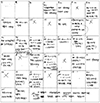Abstract
Case summary
There was a pediatric exotropia patient with large variation of prism diopter on alternate cover test at each visits. Not large enough for going through the surgery, she was recommended for the regular check-ups. Sometimes, she was orthophoria and some other times, distinct exotropia. After a few times of follow up, she showed 25-prism diopter exotropia on alternate cover test. The surgery was scheduled and she was admitted after 2 weeks. At the preoperative evaluation, she was orthophoria. She was discharged without having the surgery. To evaluate daily eyeball deviation status, the parents were asked to write a daily note on patient's eye condition. For 3-months, daily strabismus note was thoroughly reviewed and alternate cover test was performed monthly. Patch test was performed twice, and results were 10 and 12 prism diopter exotropia, each. Analyzing the note, a cycle of being the orthophoria and exotropia was noted. With the cycle of 72-hours, she was diagnosed with cyclic exotropia and the surgery was re-scheduled. Ulnilateral lateral rectus recession was performed. Without undercorrection or recurrence, she has been stayed stable over two years of follow up period.
Figures and Tables
 | Figure 2The orthphoric patient. This is when patient was admitted for the surgery. The surgery was hold since she was orthophoric in alternative cover test. |
References
1. Garg SJ, Archer SM. Consecutive cyclic exotropia after surgery for adult-onset cyclic esotropia. J AAPOS. 2007; 11:412–413.
2. Hwang JM, Kim J. Cyclic exotropia associated with retinitis pigmentosa. Graefes Arch Clin Exp Ophthalmol. 2006; 244:1549–1551.
3. Stager D Jr, Thyparampil PJ, Stager DR Sr. Cyclic exotropia in a child. J AAPOS. 2010; 14:553–554.
4. Knapp P, Allen JH. Stabismus Ophthalmic Symposium II. St. Souis: Mosby;1958. p. 488.
5. Roper-Hall MJ, Yapp JMS. Alternate day squint. In : Kimpson H, editor. First International Congress of Orthoptics. St. Louis: CV Mosby Company;1968. p. 262–271.
6. Richter CP. Clock-mechanism esotropia in children. Alternate-day squint. Johns Hopkins Med J. 1968; 122:218–223.
7. Murthy R, Hegde S. Acquired cyclic exotropia and hypotropia. J AAPOS. 2009; 13:312–314.
8. Windsor CE, Berg EF. Circadian hetrotropia. Am J Ophthalmol. 1969; 67:565–571.
9. Roper-Hall G, Cruz OA, Espinoza GM, Chung SM. Cyclic (alternate day) vertical deviation--possible forme fruste of ocular neuromyotonia. J AAPOS. 2013; 17:248–252.
10. Dawson E, Adams G, Mengher L, Lee J. Alternate day exotropia. Strabismus. 2009; 17:171–174.




 PDF
PDF ePub
ePub Citation
Citation Print
Print





 XML Download
XML Download